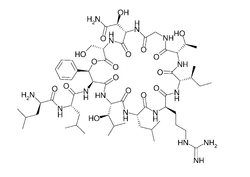Katanosin
Katanosins are a group of antibiotics (also known as lysobactins). They are natural products with strong antibacterial potency.[1] So far, katanosin A and katanosin B (lysobactin) have been described.
 | |
| Names | |
|---|---|
| IUPAC name
N-[6-(2-amino-1-hydroxy-2-oxoethyl)-15-butan-2-yl-18-[3-(diaminomethylideneamino)propyl]-12-(1-hydroxyethyl)-3-(hydroxymethyl)-24-(1-hydroxy-2-methylpropyl)-21-(2-methylpropyl)-2,5,8,11,14,17,20,23,26-nonaoxo-28-phenyl-1-oxa-4,7,10,13,16,19,22,25-octazacyclooctacos-27-yl]-2-[(2-amino-4-methylpentanoyl)amino]-4-methylpentanamide | |
| Other names
Lysobactin | |
| Identifiers | |
3D model (JSmol) |
|
| ChemSpider | |
| MeSH | B Katanosin B |
PubChem CID |
|
| |
| |
| Properties | |
| C58H97N15O17 | |
| Molar mass | 1276.502 g·mol−1 |
| Appearance | Solid |
| Density | 1.42 g/cm3 |
| Hazards | |
| Main hazards | Xn |
Except where otherwise noted, data are given for materials in their standard state (at 25 °C [77 °F], 100 kPa). | |
| Infobox references | |
Sources
Katanosins have been isolated from the fermentation broth of microorganisms, such as Cytophaga.[2] or the Gram-negative bacterium Lysobacter sp.[3]
Structure
Katanosins are cyclic depsipeptides (acylcyclodepsipeptides). These non-proteinogenic structures are not regular proteins from primary metabolism. Rather, they originate from bacterial secondary metabolism. Accordingly, various non-proteinogenic (non-ribosomal) amino acids are found in katanosins, such as 3-hydroxyleucine, 3-hydroxyasparagine, allothreonine and 3-hydroxyphenylalanine. All katanosins have a cyclic and a linear segment (“lariat structure”). The peptidic ring is closed with an ester bond (lactone).
Katanosin A and B differ in the amino acid position 7. The minor metabolite katanosin A has a valine in this position, whereas the main metabolite katanosin B carries an isoleucine.
Biological activity
Katanosin antibiotics target the bacterial cell wall biosynthesis. They are highly potent against problematic Gram-positive hospital pathogens such as staphylococci and enterococci. Their promising biological activity attracted various biological and chemical research groups. Their in-vitro potency is comparable with the current “last defence” antibiotic vancomycin.
Chemical synthesis
The first total syntheses of katanosin B (lysobactin) have been described in 2007.[4][5]
References
- Bonner, DP; O'Sullivan, J; Tanaka, SK; Clark, JM; Whitney, RR (1988). "Lysobactin, a novel antibacterial agent produced by Lysobacter sp. II. Biological properties". The Journal of Antibiotics. 41 (12): 1745–51. doi:10.7164/antibiotics.41.1745. PMID 3209466.
- O'Sullivan, J; McCullough, JE; Tymiak, AA; Kirsch, DR; Trejo, WH; Principe, PA (1988). "Lysobactin, a novel antibacterial agent produced by Lysobacter sp. I. Taxonomy, isolation and partial characterization". The Journal of Antibiotics. 41 (12): 1740–4. doi:10.7164/antibiotics.41.1740. PMID 3209465.
- Shoji, J; Hinoo, H; Matsumoto, K; Hattori, T; Yoshida, T; Matsuura, S; Kondo, E (1988). "Isolation and characterization of katanosins a and B". The Journal of Antibiotics. 41 (6): 713–8. doi:10.7164/antibiotics.41.713. PMID 3403364.
- Von Nussbaum, F; Anlauf, S; Benet-Buchholz, J; Häbich, D; Köbberling, J; Musza, L; Telser, J; Rübsamen-Waigmann, H; Brunner, NA (2007). "Structure and total synthesis of lysobactin (katanosin B)". Angewandte Chemie International Edition in English. 46 (12): 2039–42. doi:10.1002/anie.200604232. PMID 17211904.
- Guzman-Martinez, A; Lamer, R; Vannieuwenhze, MS (2007). "Total synthesis of lysobactin". Journal of the American Chemical Society. 129 (18): 6017–21. doi:10.1021/ja067648h. PMC 2151959. PMID 17432854.
6.Lee W, Schaefer K, Qiao Y, Srisuknimit V, Steinmetz H, Müller R, Kahne D, Walker S.(2016) The Mechanism of Action of Lysobactin. Journal of the American Chemical Society 138(1):100-3. doi: 10.1021